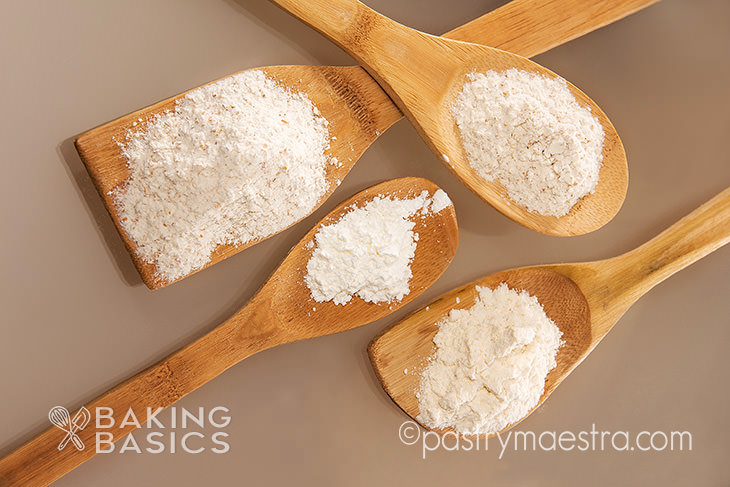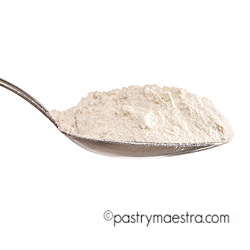

W
hile I was in Paris studying pâtisserie, I ate two baguettes a day! Yes, you’ve red it well, TWO. I absolutely love great baguette, and in Paris you can find one in any neighborhood boulangerie, especially if in the name of the place it proudly says “MOF boulanger” (I will tell you all about MOF some other time). In Paris, 85% of bread sales are baguettes. French bakers sell about 10 to 12 billion of the long breads per year! There is even a competition among Parisian masters of making this artisan everyday indulgence! Everything matters – the temperature of the water, the aroma of their homegrown yeast, the amount of salt, kneading technique, type of flour and every other step in creating this, seemingly simple, only four ingredient, 55 – 65 cm (21.6 – 25.6 inches) long bread.
Types of Flour
Flour is an ingredient produced by milling grains (wheat, rye, rice etc.), beans (soy, chickpea, beans, etc.), seeds (flax seed), nuts (almond, hazelnut, chestnut etc.), or starchy vegetables (potato).
In the western world, when the term “flour” is used, one will automatically think of wheat flour, and its principal use in baking, especially in making bread.
Wheat Flour
When making pastries, most often we use wheat flour because it gives the best texture to baked goods. To understand the differences among various types of wheat flour, you should first learn something about the wheat kernel. Wheat kernel consists of three main parts:
- The bran, which is the hard outer covering of the grain, high in dietary fiber, vitamin B and minerals. You can recognize it in whole wheat flour; it looks like tiny brownish flakes.
- When kernel sprouts, a new plant grows from the germ. Because of the high fat content, it quickly spoils and develops a bad taste.
- When the bran and the germ are removed, the white inside part of the kernel, called endosperm, remains. White flour is made from this part of the wheat kernel. Endosperm consists mostly of starch, and of some protein.
How are the Kernels Milled?
There are several ways of milling the grains. The very first way was by using pestle and mortar, but during centuries, milling has evolved greatly. Today, there are roller mills, gristmills, impact-type mills, and lots of other ways of making a grain or a nut into flour. However, most industrial mills work at very high speeds, and along with crushing the grains, they also heat the flour, which results in wasting some of its nutrients. So, even today, a stone mill is largely appreciated because it mills slowly and doesn’t rise the temperature of the flour. The result is more nutritious flour.
Composition of Wheat Flour
Flour is composed of 5 main nutrients: starches, proteins, moisture, fat and minerals.
Fat and minerals make less than 1% of wheat flour. Moisture content can vary from 11% to 14%. If the moisture content is higher, flour easily spoils. That is the main reason we keep our flour in a dry and cold place. Wheat flour consists of 6% – 15% protein. The most important proteins in flour are glutenin and gliadin (they make 80% of protein in wheat flour). When glutenin and gliadin are mixed with water, they make tough, rubbery substance – gluten. Gluten strands are plastic and elastic, and they are responsible for volume, texture and appearance of baked products.
Ash Content
What does ash content mean, is there, in fact, any ash in the flour? Well, there isn’t.
The ash content represents the quantity of bran that remained in the flour after milling. Since it is impossible to separate the bran from the endosperm completely, it was necessary to determine the quantity of the bran that is left in the flour because it affects water absorption, fermentation, gluten strength, dough color, etc.
The procedure: the miller puts a certain quantity of the flour on 900°C (1652°F). At that temperature, all organic components burn out, and what is left – the ash – are the minerals from the bran.
Treating Wheat Flour
Wheat flour should rest for several weeks after milling because while resting, it develops better baking properties. If using freshly milled flour, your dough is going to be sticky, and the final product will have less volume than the same made with aged flour. During aging process, flour oxidizes and turns white.
In order to speed the aging process, chemicals are often used. For example, potassium bromate, benzoyl peroxide and chlorine dioxide are used to remove natural yellowish color from freshly milled flour. These chemical treatments affect the aroma of the flour and destroy some nutrients in flour, too. That is why artisan bakeries choose to use unbleached flour for their production.
Enriched flour is made by adding vitamins and minerals to flour that have been lost during milling. The most often additives are thiamin, niacin, riboflavin, folic acid and iron.
Types of Wheat Flour
Depending on the type of wheat, the part of kernel milled, and the finesses of the flour, there are various types of wheat flour. Each country has its own classification.
In US there are:
- All Purpose Flour is a blend of hard and soft wheat, with 10-12% of protein.
- Self-Rising Flour is flour that contains a leavening agent – baking powder. It has limited shelf life because the baking powder absorbs moisture from the air and with time it looses its raising power.
- Bread Flour is made of hard wheat blends, and it has higher protein content; 12-14% or more.
- Cake Flour is made entirely of soft wheat containing 9% of protein.
- Wholegrain Flour contains all the bran and the germ of the kernel, and it is more nutritious than white flours.
- Graham Flour differs from whole grain flour in its production. The bran and the germ are first separated from the endosperm. The endosperm is then ground finely, and the bran and the germ are ground coarsely. The both components are recombined after milling, creating graham flour.
- Gluten Flour is flour high in protein, which was extracted from wheat flour. It contains approximately 75% of protein, and it is used in combination with weaker flours like rye flour or wholegrain flour to improve the texture of the dough.
In UK, there are:
- Soft Flour – equivalent to US pastry flour
- Plain Flour – equivalent to US all purpose flour
- Wholemeal Flour – equivalent to US whole wheat flour
In France, they use numbers, from type 45 (the most inner part of the kernel) to 150 (whole grain flour). In Germany, there are also numbers, from 405 (the most inner part of the kernel) to 1600 (whole grain flour).
Non Wheat Flours
Almond Flour
Almond flour or Almond meal is gluten-free flour made of ground sweet almonds. Almonds can be blanched before milling, which means that their skin is peeled off, or they can be ground whole. It is often used in making pastries, such as French macarons and frangipane filling, and it is the main ingredient in marzipan – almond paste.
Amaranth Flour
Amaranth flour is gluten-free flour made by grinding amaranth grain – native plant of Central America. Amaranth is rich in quality protein, iron, calcium and magnesium, and thus considered healthy for human consumption. This type of flour is gluten free, so it is suitable for making cookies, crackers or quickbreads.
Beans Flours
Beans flours are made by grinding one or several types of beans. The most common are white beans, black beans, fava beans, garbanzo (chickpea) beans, green peas, and soybeans. Beans are a great source of nutrients, namely fiber, protein and iron. You can use them in baking and as a thickener for soups, dips, and fillings.
Buckwheat Flour
Buckwheat flour is flour made by milling small seeds of a plant “fagopyrum esculentum”. This plant, despite the name “buckwheat”, isn’t related to wheat or any other grain. It is related to rhubarb, and it is, in fact, a vegetable. Buckwheat seeds are rich in protein, iron, zinc, selenium, and antioxidants. Buckwheat is gluten-free if not processed along with wheat, and it is used in making pancakes, porridges, tarts, and pasta.
Cassava Flour
Cassava flour is a very fine powder made by grinding root of the plant with lots of names – cassava, Brazilian arrowroot, manioc or tapioca. It is a plant native to South America, and when dried in a form of pearls or powder it is called tapioca. Cassava root can be cooked as is, and deep fried afterwards. Tapioca pudding is usually made of tapioca pearls, and the cassava flour is usually used as a thickener. Cassava flour is gluten-free if processed in a gluten-free environment.
Chestnut Flour
Chestnut flour is made by drying and grinding chestnuts. It is starchy, gluten-free flour, with a sweet, nutty taste, and it is often used in making desserts, as pancakes, Madeleines, and fritters.
Corn Flour
Corn flour or cornmeal is a flour ground from corn or maize. It can be ground to coarse, medium and fine consistency, and the term “corn flour” is used in US for very finely ground corn, while in UK “corn flour” is actually corn starch. Corn flour is gluten-free. It is usually used for making breads, flat breads, muffins and pancakes.
Millet Flour
Millet Flour is gluten-free flour made by grinding millet, a tiny grain rich in B vitamins, calcium, iron, potassium, magnesium and zinc. Millet can be cooked whole, popped like corn, or millet flour can be used in baking.
Oat Flour
Oat Flour is flour made by milling oats. It is gluten-free flour rich in protein and fibers. However, if oat flour is produced in the facility where is also wheat produced, it will be contaminated with gluten.
If you can’t find oat flour in your neighborhood supermarket, you can easily make it at home. You just need two ingredients: some rolled oats and a food processor. Put the oats into a food processor and pulse until you get a fine powder.
Potato Flour
Potato flour is gluten-free flour made by grinding whole dried potatoes. It is heavy, cream-colored flour, rich in starch and usually used to thicken gravies and soups, or it can be used in baking in small quantities along with other types of flour. It is important to understand the difference between potato flour and potato starch that contains only starch extracted from potato.
Quinoa Flour
Quinoa Flour is made by grinding quinoa grains, native to South America. Quinoa is rich in protein and fibers, it contains essential amino-acids, it is easily digestible and gluten-free. It has distinctive, nutty flavor. You can use it in baking, as a thickening agent for soups and sauces, or you can put it in a smoothie and protein shake. You can make quinoa flour at home, too. Put it in a food processor or a coffee grinder and pulse until finely ground.
Rice Flour
Rice flour is gluten-free flour made by finely grinding white rice, brown rice, or glutinous (sticky) rice. It is suitable for gluten sensitive and persons with celiac disease. It is usually used for making noodles, but it can be used for gluten-free baking, too.
Rye Flour
Rye flour is flour made by grinding rye grain. It comes in four forms: whole grain or rye meal, dark rye flour, medium, and white, depending on the part of the grain milled. Rye contains less gluten than wheat, so rye breads are denser and don’t rise as wheat flour breads do. Rye flour also contains a high percentage of carbohydrate gums, which makes bread dough much stickier than wheat flour one. On the other hand, rye contains much more free sugars, so that the dough will ferment quicker. Rye breads are dominant in Northern and Eastern Europe.
Sorghum Flour
Sorghum flour is made by grinding sorghum grain, a plant found in Africa. Sorghum is mostly used for animal feed, but lately it became very popular due to growing demands for gluten-free products.
Spelt Flour
Spelt flour is made by milling spelt or dinkel wheat, a species of wheat. It contains gluten, so it is easy to replace the wheat flour with spelt flour. Spelt flour has nutty and a bit sweet flavor, and it has higher protein content and it is more easily digested compared with wheat flour. There is whole spelt flour and white spelt flour (with the bran and the shell of the kernel removed) available.
Teff Flour
Teff flour is flour made by grinding the smallest grain in the world. Teff grain is native to Ethiopia, and it is a valuable source of protein, iron, calcium, fiber and B vitamin. Teff flour is gluten-free, it has a unique flavor, and it can be used to make cookies, pancakes and muffins.
It is great to have so many types of flour – many choices, many flavors to try, and even if you are a gluten-free type of bread enthusiast, there are lots of options for you! To get you started, I have few recipes that work really well! For example – baguette, or milk bread, or maybe no knead dutch oven bread to name just a few? Enjoy!



